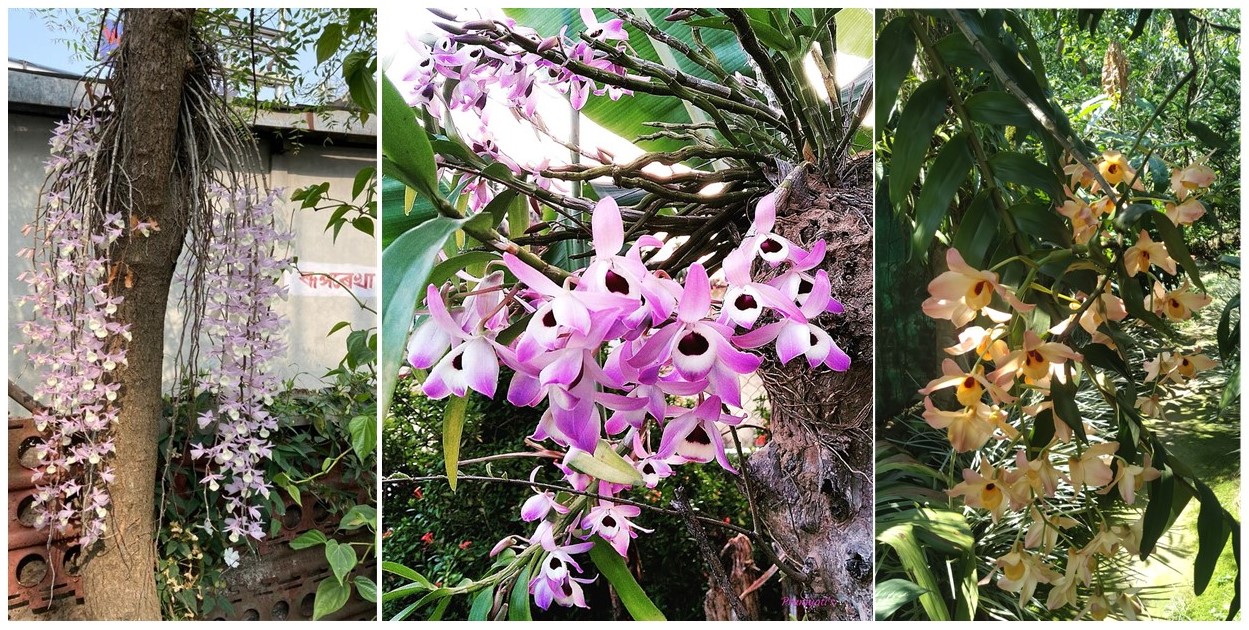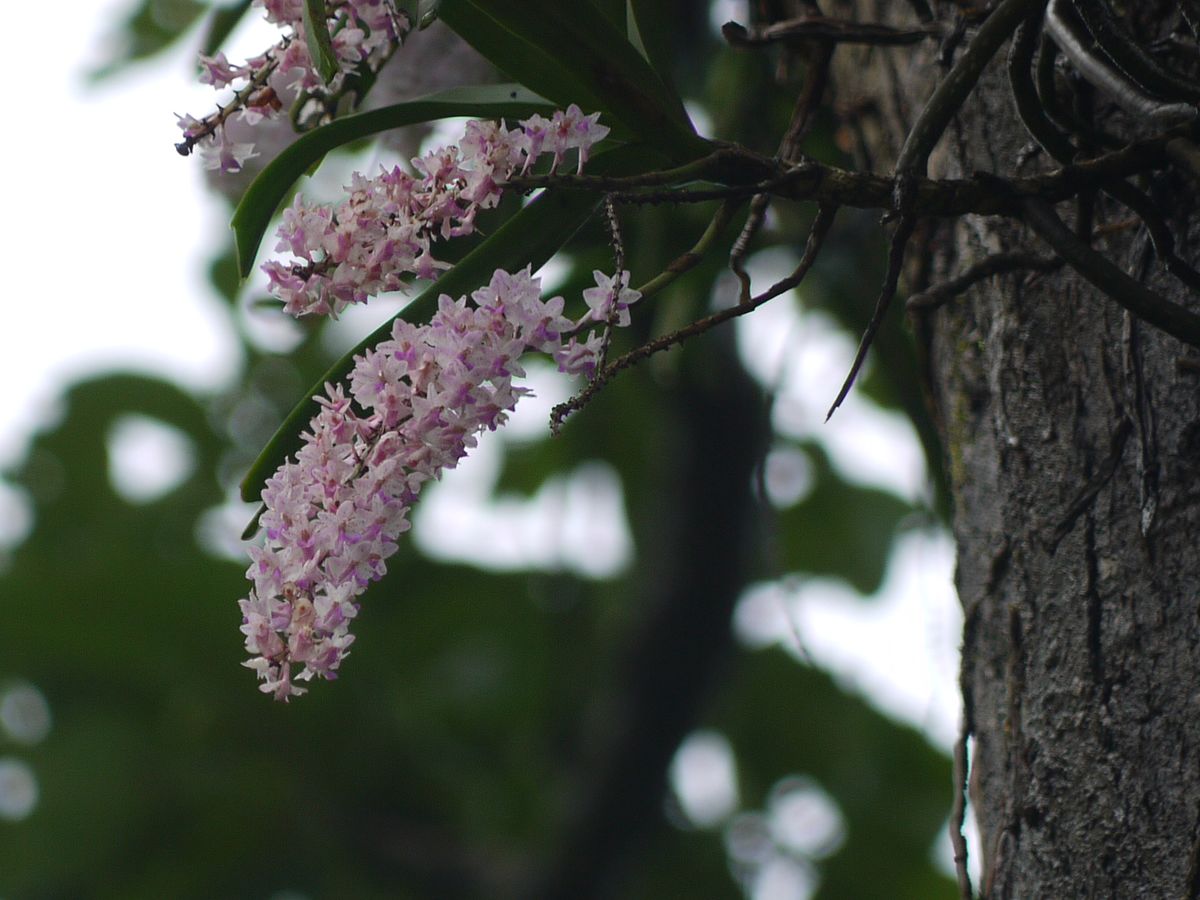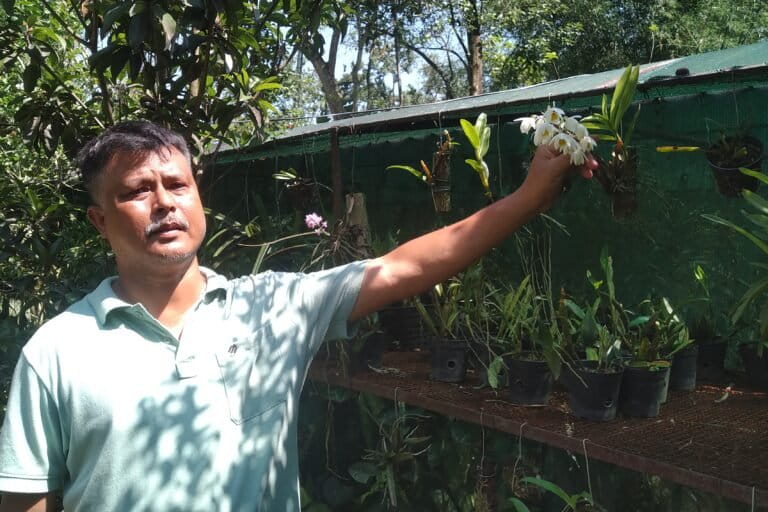- Changing climatic conditions in Assam have disrupted the blooming cycle of the foxtail orchid, traditionally associated with the Assamese new year, causing premature flowering and wilting.
- Assam is identified as one of the most climate change-vulnerable regions in the Indian Himalayan region. Higher temperatures and lesser rainfall have already impacted the state’s water resources, agriculture, forests, and unique biodiversity, including its rich orchid population.
- Shifting climates have prompted some orchid species to migrate to higher altitudes. However, these changes may not favour epiphytic orchids that rely on specific tree hosts, raising concerns about their survival and potential loss.
- Orchid conservation in India faces additional challenges, including illegal trade, deforestation, and limited protection measures. Collaborative efforts involving local communities are essential for successful conservation.
In Assam, Bohag Bihu and the kopou phool — the Assamese new year and the foxtail orchid — have an intimate connection. The blooming of this beautiful, pinkish-purple orchid on trees signifies the arrival of spring, and Bihu, which is celebrated on April 14 every year. It is a day of merriment when people dress in their traditional clothing and sing and dance to folk songs. Most of these songs are paeans to the beauty of spring, drawing similes between the blooming of the foxtail orchid, the state flower and the blossoming of young love. The orchid is also adorned by young girls on their hair while performing the Bihu dance. However, this tradition has changed over the past few years, as the kopou phool now flowers and wilts much before its time.
“The foxtail orchid would bloom during Bihu, in April, but now it is blooming in March,” Rajib Gogoi, senior scientist at the Botanical Survey of India (BSI) told Mongabay India. This, he said, is a result of changing climatic conditions, primarily an increase in temperature and change in rainfall pattern. The foxtail orchid is among the many orchids affected by these changes.

Climate and orchid migration
Orchids are good bioindicators of the health of an ecosystem. They are usually not widely spread, found only over a smaller geographical area. They do not tolerate pollution or change in their environment well. “It is for this reason that the kopou phool is now blooming and wilting away almost 10 days before Bihu in April,” said Khyanjeet Gogoi, an orchid conservationist and Botany teacher in Assam, who has to his credit the discovery of 10 orchid species — six in Arunachal Pradesh and four in Assam.
According to a report by the Ministry of Science and Technology, Assam is the most vulnerable to climate change among 12 states and union territories in the Indian Himalayan Region. The Assam State Action Plan on Climate Change (2015-2020) said that between 1951-2010, the annual mean temperature in the state has increased by 0.59 degrees Celsius, while rainfall has reduced by 2.96 mm per year. The SAPC 2021-2030 further noted that “continued warming of the atmosphere and ensuing change in precipitation pattern is impacting the state’s water resources, agriculture, forests, its unique biodiversity and the habitats of people”.

Assam has 411 recorded orchid species. In addition to the foxtail orchid (Rhynchostylis retusa) other species such as the Dendrobium aphyllum, D. moschatum, and D. lituiflorum are also flowering early, said Khyanjeet Gogoi. “Other changes that orchids are exhibiting include changes in flower colour, abnormal growth and shift to higher altitudes,” he said. D. aphyllum, for instance, was earlier found at altitudes of 200 masl (metres above sea level) but has now shifted higher, to around 800 masl. “Similarly, Aerides rosea has migrated to a higher altitude,” he said.
But while migration to higher altitudes may be more conducive for terrestrial orchids, it may not work for epiphytic ones. Orchids are mainly of three kinds: those that grow on ground, or terrestrial; those that grow on trees, or epiphytic; and those that derive nutrients from mycorrhizal fungi, or myco-heterotrophical. The issue of survival, especially for epiphytic orchids, is of concern, said Pankaj Kumar of the International Union for Conservation of Nature-Species Survival Commission (IUCN-SSC) Red List Authority for Orchids of Asia, because the “gradient is limited”.
“Orchids (usually terrestrial ones) are perennial herbs, they may begin to shift up easily. But the epiphytic ones may not be able to find a suitable habitat, so there are chances many will perish. Though the host trees will also tend to shift, it will take years before they become mature enough to be able to host orchids,” Kumar told Mongabay India. During this time, the pollinators also need to shift. “If there is no pollinator, then there will be no new recruitment through seed germination and gradually the plants will vanish too. Not all orchids are pollinator-dependent so those species may survive longer than others,” he explained. Almost 60% of all orchids found in India are epiphytic.
To add to this, a research paper said that “erratic rainfall or evaporation rate will misbalance the soil moisture, vegetation and microclimate of forest area or grassland. It will likely impact terrestrial orchid population”.

Changes in orchid flowering patterns are being observed in Arunachal Pradesh too, said Jumter Nyorak, researcher at the Tippi Orchid Research Centre in the state. This is considered the orchid state of India with 40% of the total orchid species found in India. According to the World Wildlife Fund, India has 1,256 recorded orchid species of which 307 are endemic to our country.
Nyorak also said that owing to climatic changes, some of the orchids in their natural orchidarium are beginning to die. “In Arunachal Pradesh, the average temperature in summers used to be 31-32°C maximum. Now it goes up to 37-38°C. Rainfall has also reduced, bringing down the humidity level. This is affecting the orchids.”
Read more: Warmer winters in the Kashmir Valley are leading to early flowering of the gul toor
Resilience and evolution
While they are sensitive to environmental changes, orchids are also known for their resilience. “Orchids are the first ones to inhabit a new habitat,” said Kumar.
While climate change is impacting the phenology of some orchids, Rajib Gogoi explains that “globally, scientists are not considering it a serious problem because similar changes have happened earlier, about 100 years earlier, and orchids have evolved.”
“Having said that, the conditions that existed 100 years before are not the same as now,” he added. “Pollution levels for instance have increased so much. So, sustainability in such conditions must be considered.”
A shrinking forest cover, say all experts, is a major challenge when it comes to orchid conservation. “Orchids don’t inhabit all trees. The indiscriminate cutting down of trees is posing a threat to these plants,” said Khyanjeet Gogoi.

The illegal orchid trade
Illegal trade is another challenge. According to Merwyn Fernandes of WWF, unsustainable harvesting practices and illegal trade, combined with limited protection measures and lack of awareness, make the future of orchids a serious concern. In India, 11 species of orchids are protected under the Wildlife (Protection) Act 1972.
“Orchids are high in demand for ornamental purposes, for medicinal purposes, and for research,” said Khyanjeet Gogoi. The stem of plants of the Dendrobium genera, for instance, is used in traditional Chinese medicine to treat ailments like gastritis, fever, skin ageing, even cancer. In northeast India, the illegal trade of orchids occurs mainly in Manipur and Meghalaya through Assam, he added.
“Agencies must take responsibility in the implementation of laws and protection of wild orchid species. The forest department should also ensure the protection of forest cover. Ex-situ and in-situ conservation of orchids and involvement of the local community can help in conservation efforts,” said Rajib Gogoi. He added that incentivising the local community to aid such efforts would go a long way in truly bringing about a change.
Read more: Ain’t no mountain high enough: alien invasive plants increasing in higher elevations
Banner image: The foxtail orchid, photographed here in Dandeli, is also found in other parts of the country. Photo by Chiring chandan/Wikimedia Commons.
